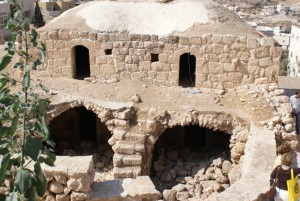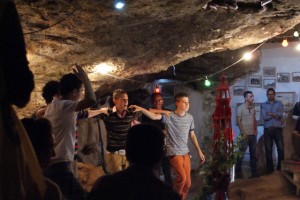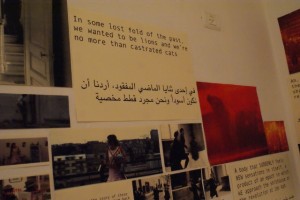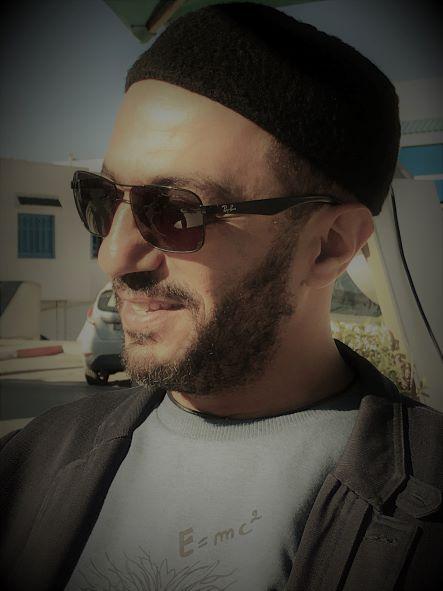The art of Palestinian resistance
By Khaled Diab
Can art help the Palestinian struggle or is it a preoccupation those living under occupation can ill-afford?
Monday 3 December 2012

Although the Palestinians have a rich and varied cultural heritage, art and culture has fallen victim to the conflict. For example, in East Jerusalem, where I live, Israeli clampdowns since the second intifada, the construction of the separation wall, as well as a lack of resources, have led to such a decline in what was once the Palestinians' cultural capital that it no longer even had a functioning cinema until earlier this year.
“We have a cultural vacuum and it is because the occupation has erased our identities,” believes Rima Essa, a Palestinian film director and the curator of the new cinema at the Yabous Centre, which is located in the former premises of the al-Quds cinema.
However, in recent years, the artistic and cultural communities have been finding new ways to regroup and reclaim their fragmented creative space. Palestine's physical and political fragmentation is mirrored in the cultural scene, where artists and institutions often work in isolation. To address this, seven Palestinian cultural organisations have joined forces to organise a new festival, Qalandiya International, which ran across the West Bank for the first half of November.
Qalandiya is the point where three physical realities of the plight of Palestinians converge: a massive military checkpoint-cum-de-facto-border-crossing, a monstrous concrete wall, and a decades-old refugee camp which has evolved into a poor slum area where disillusioned and disgruntled youth clash regularly with Israeli forces.
But it wasn't always this way. Qalandiya was once just a sleepy Palestinian village (which still exists) perched between Jerusalem and Ramallah. It was also home to mandate Palestine's first international airport, its portal to the outside world.
This conflicting symbolism – despair and hope, freedom and subjugation, escape and imprisonment – made Qalandiya the ideal name for the biennial festival. “It represents our history and suffering,” says Jack Persekian, the artistic director of the festival and the founder of the al-Ma'mal Foundation for Contemporary Art.
The festival features a wide range of art – from video and installation to painting and literature – and architecture, including walks and talks, organised by Riwaq, an NGO that seeks to document and conserve Palestine's architectural heritage, which has incorporated its own biennial into Qalandiya International.

I joined a tour to Dhahariya, where Riwaq has implemented an ambitious project to restore and conserve this small town's historic centre, constructed around an ancient Byzantine fort.
It is said that writing about music is like dancing about architecture. But the locals proved to us that “dancing about architecture” is not such a bizarre concept, when schoolchildren put on a performance of the traditional Palestinian dabke dance in honour of the revival of their old town, which had previously lay crumbling and almost entirely abandoned.
With a court house, a community centre, and even a local, grassroots radio station, the first of its kind in southern Palestine, life has returned to the Dhahariya's historic centre. People I encountered on the streets appeared to be very proud of the architectural and cultural renaissance which has visited their village, including the new broadcaster, manned almost entirely by young volunteers, set up entirely for them. “Dhahariya is a marginalised community and we give it a voice,” said a young male presenter.

“Everywhere you walk on the streets, you hear our station playing,” added his female colleague proudly.
Dhahariya is one of the poster villages for Riwaq's project to restore 50 historic town and village centres which together represent 50% of Palestine's built heritage, explained Riwaq's co-director Khaldun Bishara. This novel approach, which I feel can be employed in other places where resources are tight, seeks to arrest the decline in Palestine's cultural heritage, which has been accelerated by the Israeli occupation, inadequate legislation, overcrowding and a culture that still tends to value the new over the old, Bishara elaborates.
Although Riwaq's work is not overtly political, against the bitter backdrop of the Israeli-Palestinian conflict, architectural heritage and archaeology are, at least implicitly, highly politicised. But there is far more to it than politics.
Suad Amiry – the founder of Riwaq who has become a well-known writer around the world since publishing her acclaimed humorous diary of daily life under siege in Ramallah during the second intifada, Sharon and My Mother-in-Law – says that what inspired her to enter conservation was the “organic connection” she felt with traditional Palestinian architecture, which she believes blends seamlessly into the landscape and is more in tune with nature, the climate and people's needs than modern building styles.
But it is not just about aesthetics, it is about communities, Bishara insists, outlining how Riwaq pursues a holistic approach to their restoration projects – which takes into account cultural and economic factors – to ensure that the restored centres become living spaces and not open air museums.
He adds that the Riwaq approach transforms restoration and conservation into a highly effective job creation and skills building mechanism. “Per dollar, our projects create more work than most comparable development activities,” he told me, “and we equip people with useful skills they can then exploit elsewhere.”
On touring other parts of the Qalandiya International festival, I was genuinely impressed by some of the art and a few of the venues. One new venue in the troubled old city of Jerusalem was a derelict tile factory which, through creativity, has been reinvented and reborn as a haunting and evocative exhibition space.

Inside are installations about the “parallel time” experienced by a Palestinian prisoner of conscience who has spent most of his adult life in Israeli prisons, a Muslim father and son in Bethlehem who make crowns of thorns for Christian pilgrims, and two “incidental insurgents” who go on a road trip through the West Bank ghetto.
Creative as such endeavours are, sceptics might wonder what difference art can make to change the reality on the ground and whether it is a preoccupation that Palestinians can ill afford amid the realities of occupation. “If art were only concerned with aesthetics, I would say this was right,” asserts Persekian. “By giving young artists and innovators the chance, they can present new ideas for exiting this impasse.”
Personally, I have been impressed by the active role young artists are playing at the grassroots level, from the street art on the separation wall to the highly successful graphics of blindfolded Palestinian prisoners in brown smocks which were used as profile pictures by many Facebook users to express solidarity for hunger strikers in Israeli prisoners. That is not to mention the pop artists, such as the hip hop group Dam who have just released a song against honour killings, and stand-up comics.
For his part, Persekian is convinced that Palestinian art, which he says once sat on the sidelines and sufficed itself with observing, interpreting and expressing the Palestinian demise, now stands at the very heart of the Palestinian struggle. “Young artists have become an inseparable component of much of what is going on in the country,” he says.
Persekian may well be right about the mainstreaming of art and culture, but I feel this is somewhat unfair to previous generations. Take Ghassan Kanafani. Not only did his stories have a profound influence in shaping modern Palestinian consciousness, he was also politically active with the Popular Front for the Liberation of Palestine, something he paid for with his life.
But there are those, even among Palestinians, who believe that art and politics should not mix. “Art is art. I try to do art for art's sake,” Nasser Zalloum, an expatriate Palestinian artist exhibiting at the festival, told me.
Regardless of whether or not art can really be divorced from politics, Palestinian art is intimately and inseparably linked to the Palestinian cause. Once the Palestinian people gain their freedom, then their art too can be liberated from politics. I look forward to that day.
—
Follow Khaled Diab on Twitter.
This article first appeared in The Huffington Post on 16 November 2012.



nicely done.
Nice. You’re going! American Mainstream!! j/k, good article, Khaled.